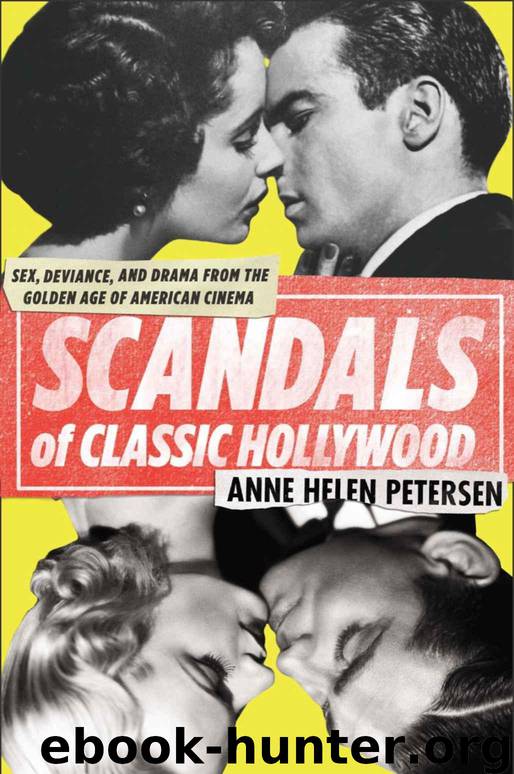Scandals of Classic Hollywood: Sex, Deviance, and Drama from the Golden Age of American Cinema by Anne Helen Petersen

Author:Anne Helen Petersen [Petersen, Anne Helen]
Language: eng
Format: mobi
Publisher: Penguin Group US
Published: 2014-09-30T00:00:00+00:00
VOLUME FIVE
BROKEN BY THE SYSTEM
At the peak of the studio system, Hollywood stardom was engineered to be every girl’s fantasy: the glamour, the clothes, the handsome costars. And that dream was the studio’s most valuable product, as the desire that underpinned it could be funneled directly into the purchase of movie tickets. There wasn’t much to disprove that dream—even the faded stars of the silent age, such as Mary Pickford and Gloria Swanson, still seemed resplendent in their spoils, as glamorous as ever. With the vivid exception of Clara Bow, the Hollywood of the 1930s seemed to be a healthy, happy place to be, a giant playground for Shirley Temple and a sprawling dance floor for Ginger Rogers.
But as World War II drew to a close, the studios began to transform. The so-called Paramount Decrees, issued by the federal government to uphold antitrust practices, required the major studios to divest themselves of the theater chains that had helped them monopolize the industry. Over the next ten years, the studio system would disassemble itself and, in so doing, forever alter the way movies were made, funded, and distributed, as well as how the stars of those movies were groomed, cultivated, and maintained.
Amid this process, the veneer of the perfect, glamorous Hollywood—and its perfect, happy stars—began to crack. It wasn’t just that the stars were fooling around or, like Robert Mitchum, smoking dope; it’s that the studio itself was revealed as a factory, its workers miserable, overworked, and broken. The most dramatic proof of this unseemly underbelly was Judy Garland, who effectively grew up on the MGM lot and whose continual struggles with drugs, alcohol, and men were framed as the direct result of overwork and psychological abuse at the hands of her employer.
But the reorganization of Hollywood wasn’t all bad—it made way for independent productions, including those that targeted “niche” audiences, paving the way for the first wave of African American stars, including Harry Belafonte, Sidney Poitier, and Dorothy Dandridge. With her role in Carmen Jones, Dandridge rocketed to fame, only to watch her stardom dwindle to nothing over the course of the next four years. Like Garland, Dandridge was broken by the system that built her, only in ways shaded with insidious racism and systemic forms of discrimination. When Garland died at the age of forty-seven, she was trumpeted as a survivor; when Dandridge died at forty-two, she barely made the papers. Her story, paired with Garland’s, provides a lucid picture of an industry that was the stuff not of dreams, but of nightmares—a sentiment that would make it easy to celebrate the stars’ emancipation from the studios and tolerate the bloated salaries and extravagant demands that followed.
Download
This site does not store any files on its server. We only index and link to content provided by other sites. Please contact the content providers to delete copyright contents if any and email us, we'll remove relevant links or contents immediately.
| African Americans | Civil War |
| Colonial Period | Immigrants |
| Revolution & Founding | State & Local |
Cat's cradle by Kurt Vonnegut(13856)
Pimp by Iceberg Slim(12923)
Underground: A Human History of the Worlds Beneath Our Feet by Will Hunt(11251)
4 3 2 1: A Novel by Paul Auster(11034)
The Radium Girls by Kate Moore(10902)
American History Stories, Volume III (Yesterday's Classics) by Pratt Mara L(4821)
Perfect Rhythm by Jae(4616)
Wiseguy by Nicholas Pileggi(4582)
The Fire Next Time by James Baldwin(4336)
Paper Towns by Green John(4163)
A Higher Loyalty: Truth, Lies, and Leadership by James Comey(4025)
Pale Blue Dot by Carl Sagan(3996)
The Mayflower and the Pilgrims' New World by Nathaniel Philbrick(3905)
The Doomsday Machine by Daniel Ellsberg(3725)
Too Much and Not the Mood by Durga Chew-Bose(3689)
Killers of the Flower Moon: The Osage Murders and the Birth of the FBI by David Grann(3605)
The Borden Murders by Sarah Miller(3581)
The Sympathizer by Viet Thanh Nguyen(3467)
Killing England by Bill O'Reilly(3449)
